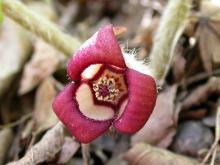Wildflowers, Grasses and Other Nonwoody Plants
Media

Species Types
Scientific Name
Polemonium reptans
Description
As pretty as this wildflower is, the common name “Jacob’s Ladder” comes from its ladderlike leaves, which made people think of the story from Genesis in which Jacob dreams of a ladder reaching up to heaven.
Media

Species Types
Scientific Name
Trillium sessile
Description
The flower of wake robin, or trillium, has 3 petals and 3 sepals, and 3 leaves that subtend the solitary flower. The petal color varies in this common woodland spring wildflower, but it is most commonly brownish or maroon.
Media

Species Types
Scientific Name
Trillium flexipes
Description
The largest trillium in Missouri has white petals, and when it blooms in spring, the flowers droop or hang sideways. Look for white wake robin in eastern and east-central Missouri, and in counties bordering the Missouri River.
Media

Species Types
Scientific Name
Asarum canadense
Description
In spring, wildflower lovers locate wild ginger by looking for its unique, hairy, heart-shaped leaves, then by stooping to view the small, three-parted brown flowers that form between the leaf bases, close to the ground.
Species Types
Scientific Name
Lespedeza thunbergii
Description
Thunberg’s lespedeza is a large, nonwoody perennial shrub often cultivated as a showy, flowering ornamental. It sometimes escapes from cultivation and naturalizes in Missouri landscapes.
Media

Species Types
Scientific Name
Solidago spp. (23 species in Missouri)
Description
There are 23 species of goldenrods in Missouri. They can be hard to identify to species, but as a group, the goldenrods are common and nearly unmistakable.
Media

Species Types
Scientific Name
Senna marilandica (formerly Cassia marilandica)
Description
The flowers of southern wild senna don’t look much like typical pea-family flowers, but its leaves and bean pods show the family resemblance. Look for it in moist situations, mostly south of the Missouri River.
Media

Species Types
Scientific Name
Dioscorea oppositifolia (sometimes called D. batatas)
Description
Similar to kudzu, Chinese yam is an aggressive vine that overtakes nearly everything within reach that stands still long enough! Learn more about this invasive plant — and please don’t plant it!
Media

Species Types
Scientific Name
Asclepias incarnata
Description
Swamp milkweed has pink flower clusters at the tips of its tall stalks. The leaves are opposite, narrow, and up to 6 inches long. It grows in moist bottomland soils.
Media

Species Types
Scientific Name
Physostegia virginiana
Description
False dragonhead is called "obedient plant" because when you push one of the flowers sideways, it "obediently" stays in place for a while.
See Also
About Wildflowers, Grasses and Other Nonwoody Plants in Missouri
A very simple way of thinking about the green world is to divide the vascular plants into two groups: woody and nonwoody (or herbaceous). But this is an artificial division; many plant families include some species that are woody and some that are not. The diversity of nonwoody vascular plants is staggering! Think of all the ferns, grasses, sedges, lilies, peas, sunflowers, nightshades, milkweeds, mustards, mints, and mallows — weeds and wildflowers — and many more!





















